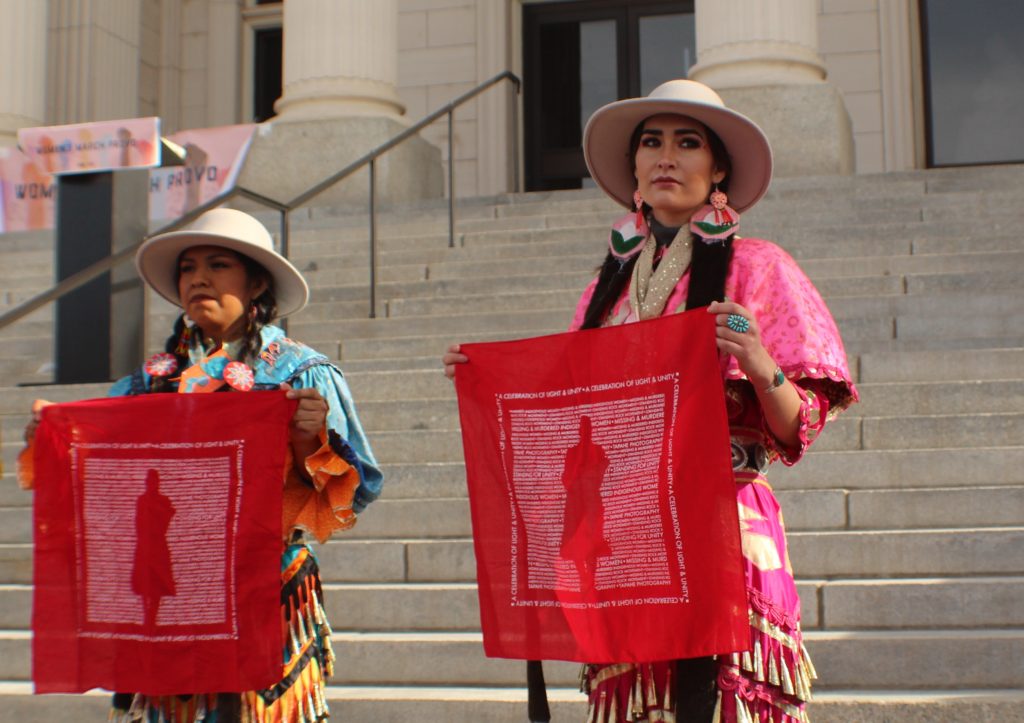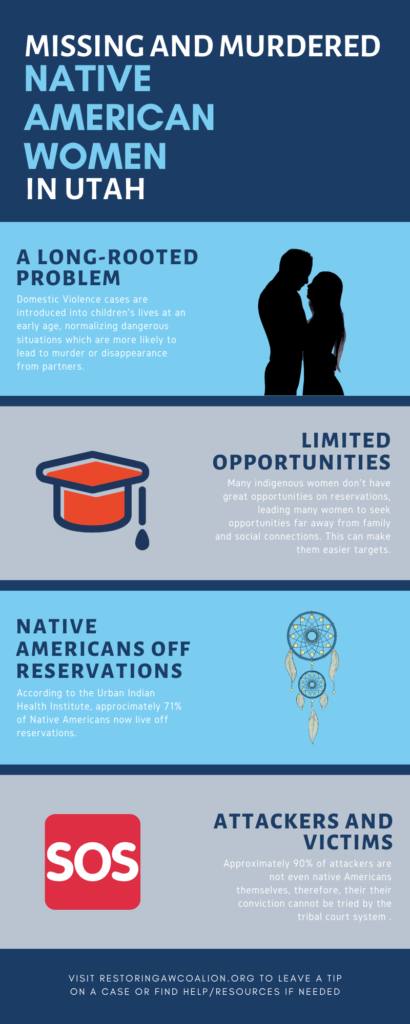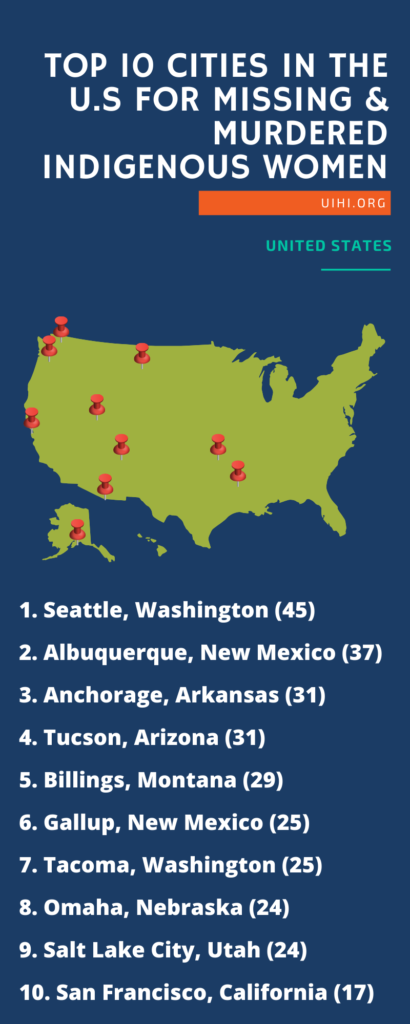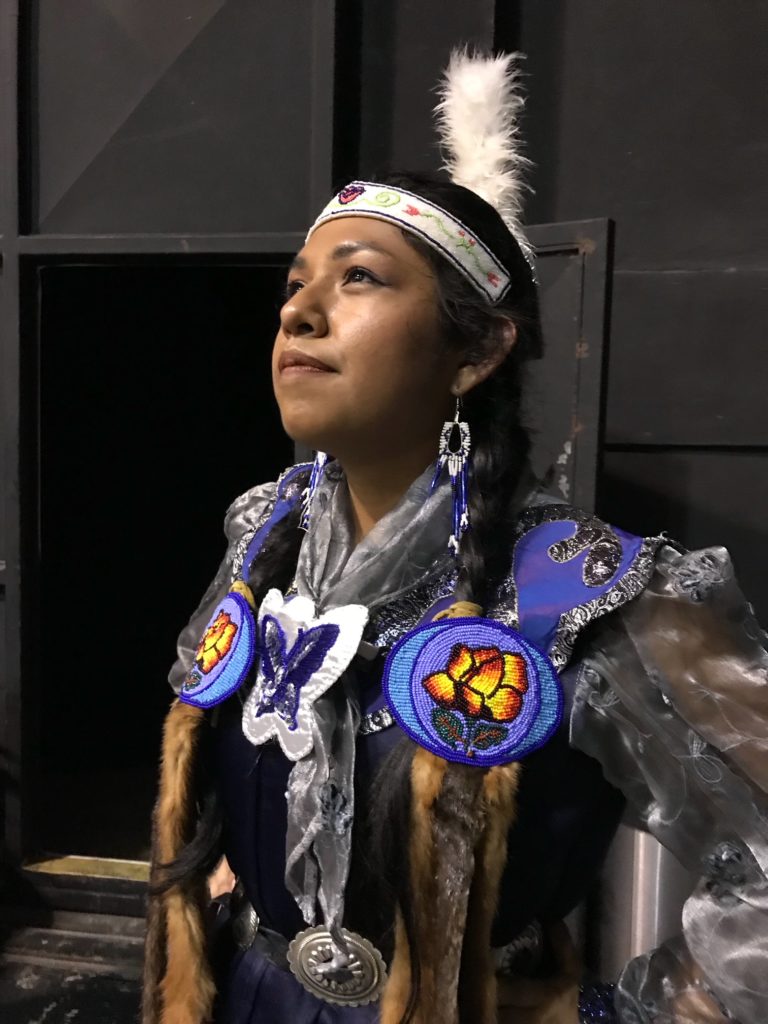Leer en español: La comunidad de BYU habla acerca de la desaparición y muerte de mujeres nativo-americanas

Savanna LaFontaine-Greywind was eight months pregnant and returning to her home in Fargo, North Dakota, one day in August, when a neighbor asked her if she could help model a sewing project. LaFontaine-Greywind agreed to help and went upstairs. She never returned.
LaFontaine-Greywind’s body was retrieved from a river days later, her baby, merely a month away from its due date, having been cut from her womb with a box-cutter-type blade.
Police searched the apartment of the individuals who kidnapped LaFontaine-Greywind and found the baby days after LaFontaine-Greywind’s reported disappearance.
LaFontaine-Greywind is one of many Native American women targeted and killed every year.
Her tragedy sparked Savanna’s Act, which was introduced to the U.S. Senate in January. If passed, the act would require the U.S. attorney general to review, revise and develop law enforcement and justice protocols addressing missing and murdered Native Americans.
The issue of unreported cases of missing and murdered Native American women has continued to affect families and friends seeking closure for their lost relatives. Advocacy groups, along with Native American professors and students at BYU, are hoping to raise awareness about the issue.
While this issue occurs throughout the United States and Canada, Salt Lake City has the ninth highest number of missing and murdered indigenous women and girls in the United States, according to the Urban Indian Health Institute.
Legislation like the Violence Against Women Act — which added provisions for Native American women and coalitions to combat domestic violence within tribes regardless of geographic boundaries — and organizations like Restoring Ancestral Winds (RAW) are some of the resources different individuals are using to try to tackle the issue of missing and murdered Native American women.
RAW, a center for helping Native Americans who have suffered from sexual assault and domestic violence, is working alongside tribes in the Great Basin area, which includes half of Utah, most of Nevada and sections of Idaho, Wyoming, Oregon and California.
Moroni Benally, RAW advocacy and public policy coordinator, said there is a bigger issue to be understood when discussing the topic of domestic violence and missing persons cases involving Native Americans.
“We have to start talking about the pathways of how that (disappearances and murders of Native American women) happens,” Benally said.
One overlooked factor Benally discussed was the feeling of rejection from communities of “two-spirit” or LGBT youth on reservations. Rejection increases their risk of suicide and their chances of being coerced into sex trafficking or eventually becoming murder victims, Benally said.
“One of the reasons it hasn’t received a lot of attention, or hasn’t received the necessary resources until now, is in part because a lot of these victims were not the iconic victim; they weren’t the white, blonde-haired young woman,” Benally said.

He said many of these issues start with “the historical trauma of these communities.”
Many Native Americans no longer live on reservations, which makes tracking them the state’s responsibility instead of their tribe’s, according to Benally. This is supported by the 2010 U.S. Census, which found 78% of Native Americans lived outside of American Indian and Alaska Native areas.
Many of them leave reservations with the intention of looking for better opportunities than those available to them on the reservation.
“They’re already vulnerable, they’re dispossessed of their communities and they don’t have the skills to make it, and so they end up in very vulnerable situations,” Benally said. “The perpetrators know what to look for; they know how to find the victims.”
He said a contributing factor to many of these cases has to do with the normalization of domestic violence some women experience because of early exposure to violence in the home. This issue perpetuates far beyond just kidnappings and murders, it has been rooted into the core of their culture for decades, he said.
“If you could find a single Native American who has not been touched by this (the disappearances and murders of Native American women), in some personal way, it would be a miracle,” Benally said.
Benally and RAW work closely with local police departments and other organizations to help provide the best resources to victims and their families.
Jason Jensen, a private investigator and co-founder of the Utah Cold Case Coalition, has worked since 2017 to help solve cold cases throughout Utah. However, since the coalition’s early stages, Jensen has only worked on one case involving Native Americans.
“Oftentimes, things don’t get reported because they try to handle it on the reservation,” Jensen said.
The degrees that state and local governments can intervene on reservations also inhibit some victims and potential victims from seeking the safety they desire.
“Due to laws surrounding their nations, they (reservations) are usually a safe haven for criminals to be on,” Jensen said.
Jensen said there are many misconceptions around these Native American victims. One misconception he pointed out is the lack of reporting to state officials when missing women return to their tribes.
Government officials see the need for change in these communities and are doing their part to make a difference.
State Rep. Angela Romero helped pass a resolution to have May 5 recognized as Missing and Murdered Indigenous Women, Girls and LGBT Awareness Day. Gov. Gary Herbert signed the resolution on March 25, 2019.
Romero has worked closely with organizations, such as the Utah Department of Public Safety and RAW, to help bring awareness to and promote advocacy for this issue.

“In order to show it’s a crisis, we need to quantify the data,” Romero said. “It’s a much more complex issue.”
Romero, who has Native American and Hispanic lineage, said she felt a need to have these communities better represented and hopes to do so during her time in office.
BYU law professor Michalyn Steele said although she has not personally dealt with such cases, being a Native American has made her well aware of the issue.
“I’m not aware of anyone in my personal circle that has been murdered or is missing. But you don’t have to look far into the Native American community to see these tragic stories unfolding week after week, year after year,” Steele said.
She said she has seen laws move toward enhancing tribal jurisdiction and the legal matters that take place on the reservations.
“It hasn’t gone far enough, but I have seen movement,” Steele said.
This issue reaches far beyond the Native American soil in the United States; it also affects the first nation tribes in Canada, she said.
“Crimes against native or indigenous women need to be treated as seriously as crimes against anyone else,” Steele said.
A way to tackle the issue in a more serious manner would be to add better investigative and prosecutorial guidelines and procedures, she said.
BYU education professor Roni Jo Draper said it is important for her to discuss such topics in class and help students be aware of problematic issues surrounding them.
Draper is also a member of the Yurok tribe in Reno, Nevada, where she grew up and attended college.
Though Draper does not live on the Yurok reservation, she has family members who do. She said her periodic visits helped her notice the lack of resources and representation the individuals on reservations deal with daily.
“I think we maybe have a misunderstanding that it’s just this geographical location,” Draper said, adding that there are more tribal members who live off the reservation than live on the it, so those protections need to be extended.
Legal complexities between Native Americans who live on and off reservations make each case unique with different precautions depending on the scenario.
Very few individuals know the severity of the issue because of representation and reporting of the cases that are investigated. Draper said she thinks more could be done to inform those who may be unaware of the issue.
“I don’t think there has been enough attention around (the cases),” Draper said. “There are so many hard things in the world, and this may just seem like one more.”
Draper said in addition to the lack of coverage around this issue, there are many overlooked variables that directly contribute to the murders and disappearances of these women, something she said needs to be addressed.

BYU student Victoria Meza, who is part Navajo, said despite her understanding of life off a reservation, she sees the struggle of being raised on reservations from her summer visits with family.
“My grandparents chose to raise my mother also off the reservation because, from their experience, living on a reservation just wasn’t the experience they wanted their children to live,” Meza said
She said she felt she had adequate resources as a Native American woman not living on a reservation to feel safe but that it would be different if she had lived on one.
This is partially because of the lack of resources like police enforcement, she said.
Meza said she understands some women decide to stay on a reservation despite difficult circumstances because of their connection to the land and feeling like a part of them would be missing if they left.




